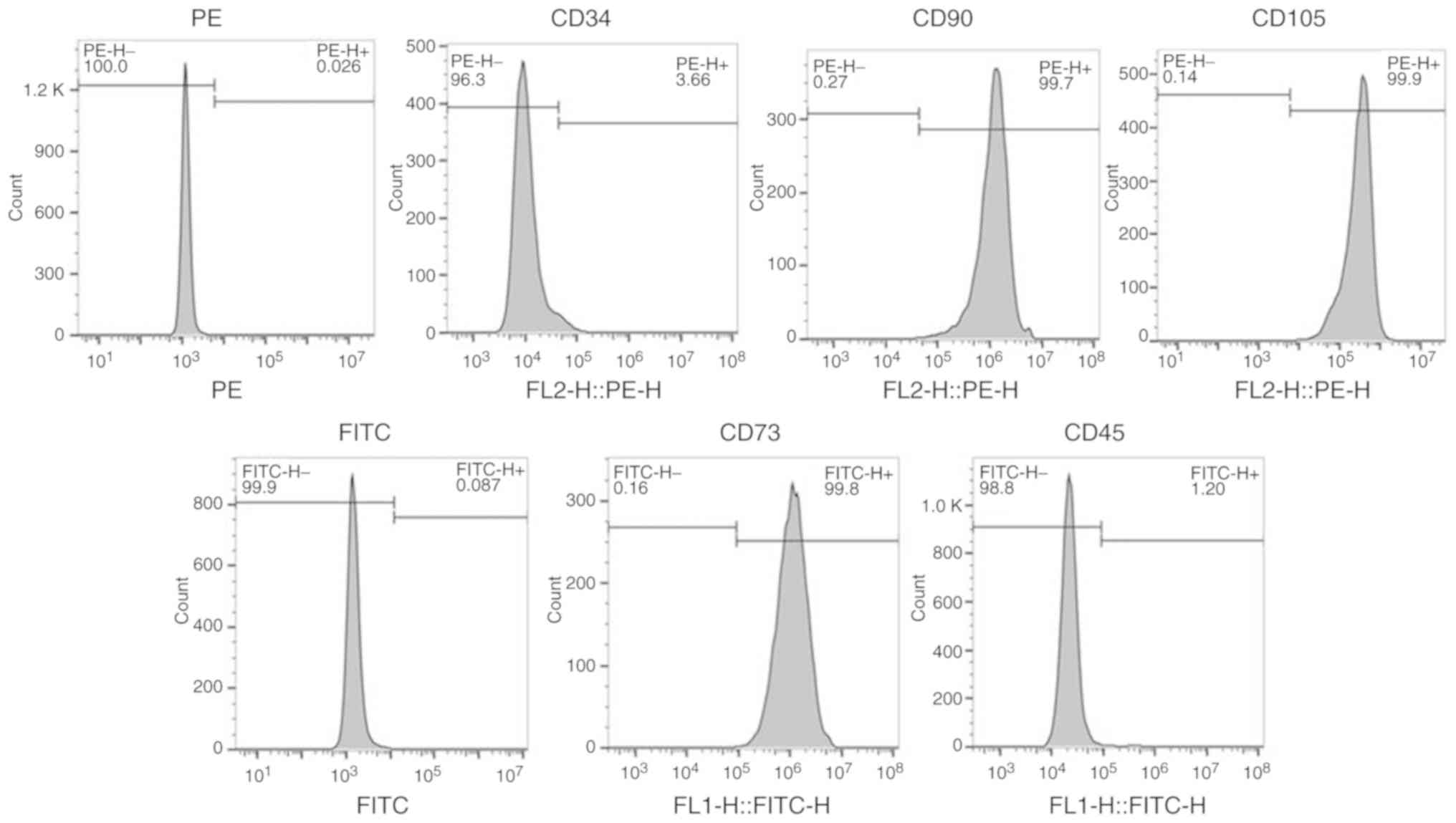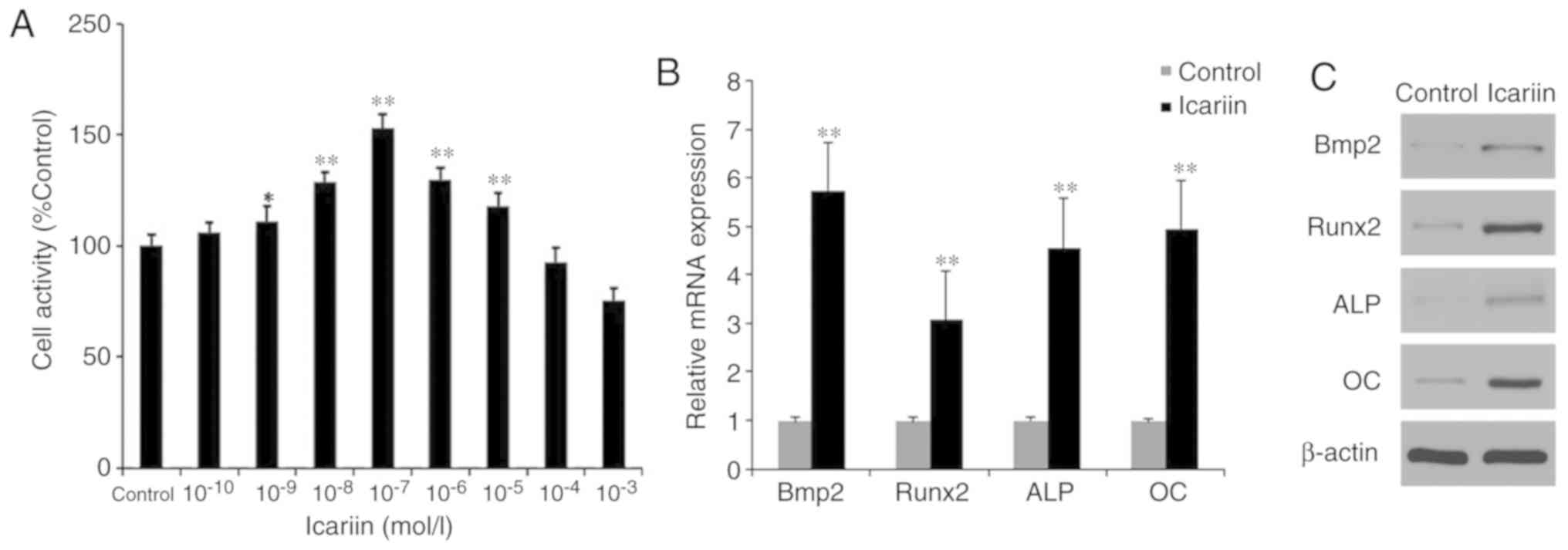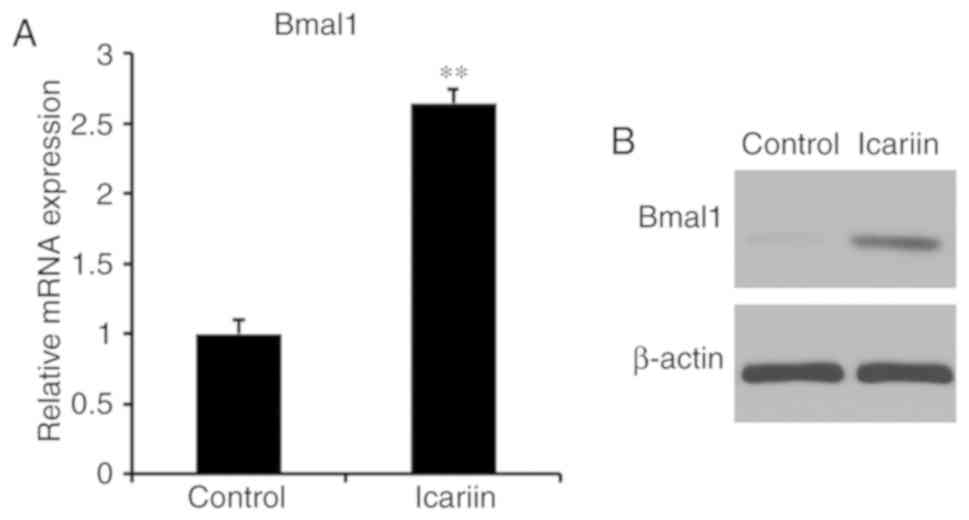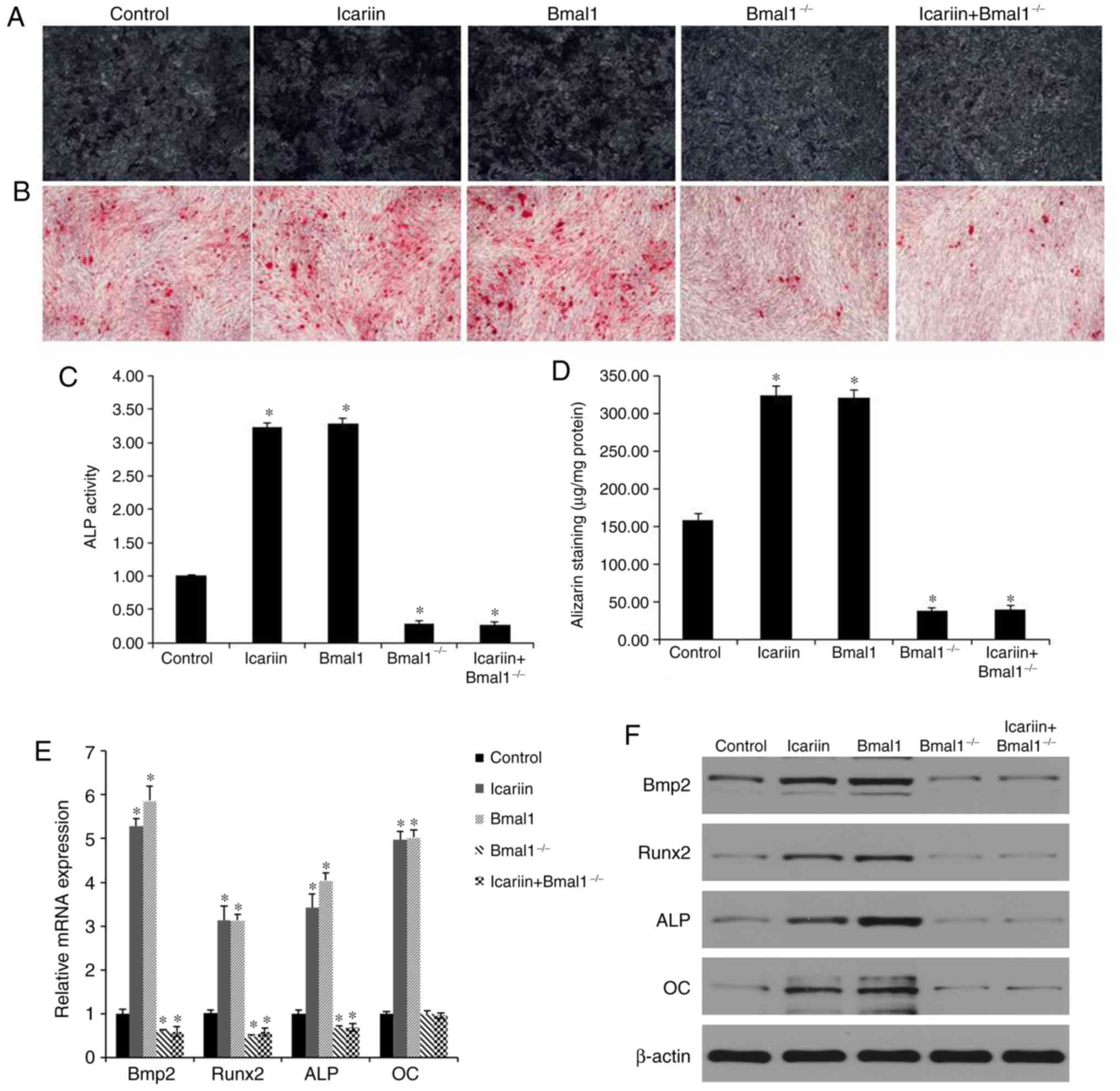|
1
|
Mankin HJ: Nontraumatic necrosis of bone
(osteonecrosis). N Engl J Med. 326:1473–1479. 1992. View Article : Google Scholar : PubMed/NCBI
|
|
2
|
Yu Y, Zhang Y, Wu J, Sun Y, Xiong Z, Niu
F, Lei L, Du S, Chen P and Yang Z: Genetic polymorphisms in IL1B
predict susceptibility to steroid-induced osteonecrosis of the
femoral head in Chinese Han population. Osteoporos Int. 30:871–877.
2019. View Article : Google Scholar : PubMed/NCBI
|
|
3
|
Mont MA, Cherian JJ, Sierra RJ, Jones LC
and Lieberman JR: Nontraumatic osteonecrosis of the femoral head:
Where do we stand today? A ten-year update. J Bone Joint Surg Am.
97:1604–1627. 2015. View Article : Google Scholar : PubMed/NCBI
|
|
4
|
Shui C, Spelsberg TC, Riggs BL and Khosla
S: Changes in Runx2/Cbfa1 expression and activity during
osteoblastic differentiation of human bone marrow stromal cells. J
Bone Miner Res. 18:213–221. 2003. View Article : Google Scholar : PubMed/NCBI
|
|
5
|
Samsa WE, Vasanji A, Midura RJ and
Kondratov RV: Deficiency of circadian clock protein BMAL1 in mice
results in a low bone mass phenotype. Bone. 84:194–203. 2016.
View Article : Google Scholar : PubMed/NCBI
|
|
6
|
He Y, Chen Y, Zhao Q and Tan Z: Roles of
brain and muscle ARNT-like 1 and Wnt antagonist Dkk1 during
osteogenesis of bone marrow stromal cells. Cell Prolif. 46:644–653.
2013. View Article : Google Scholar : PubMed/NCBI
|
|
7
|
Mohawk JA, Green CB and Takahashi JS:
Central and peripheral circadian clocks in mammals. Annu Rev
Neurosci. 35:445–462. 2012. View Article : Google Scholar : PubMed/NCBI
|
|
8
|
Richards J and Gumz ML: Mechanism of the
circadian clock in physiology. Am J Physiol Regul Integr Comp
Physiol. 304:R1053–R1064. 2013. View Article : Google Scholar : PubMed/NCBI
|
|
9
|
DeBruyne JP, Weaver DR and Dallmann R: The
hepatic circadian clock modulates xenobiotic metabolism in mice. J
Biol Rhythms. 29:277–287. 2014. View Article : Google Scholar : PubMed/NCBI
|
|
10
|
Zmrzljak UP and Rozman D: Circadian
regulation of the hepatic endobiotic and xenobitoic detoxification
pathways: The time matters. Chem Res Toxicol. 25:811–824. 2012.
View Article : Google Scholar : PubMed/NCBI
|
|
11
|
Bailey SM, Udoh US and Young ME: Circadian
regulation of metabolism. J Endocrinol. 222:R75–R96. 2014.
View Article : Google Scholar : PubMed/NCBI
|
|
12
|
Miranda J, Portillo MP, Madrid JA, Arias
N, Macarulla MT and Garaulet M: Effects of resveratrol on changes
induced by high-fat feeding on clock genes in rats. Br J Nutr.
110:1421–1428. 2013. View Article : Google Scholar : PubMed/NCBI
|
|
13
|
Chen P, Kakan X and Zhang J: Altered
circadian rhythm of the clock genes in fibrotic livers induced by
carbon tetrachloride. FEBS Lett. 584:1597–1601. 2010. View Article : Google Scholar : PubMed/NCBI
|
|
14
|
Gabás-Rivera C, Martínez-Beamonte R, Ríos
JL, Navarro MA, Surra JC, Arnal C, Rodríguez-Yoldi MJ and Osada J:
Dietary oleanolic acid mediates circadian clock gene expression in
liver independently of diet and animal model but requires
apolipoprotein A1. J Nutr Biochem. 24:2100–2109. 2013. View Article : Google Scholar : PubMed/NCBI
|
|
15
|
Huang Z, Cheng C, Wang J, Liu X, Wei H,
Han Y, Yang S and Wang X: Icariin regulates the osteoblast
differentiation and cell proliferation of MC3T3-E1 cells through
microRNA-153 by targeting Runt-related transcription factor 2. Exp
Ther Med. 15:5159–5166. 2018.PubMed/NCBI
|
|
16
|
Huang Z, Cheng C, Cao B, Wang J, Wei H,
Liu X, Han Y, Yang S and Wang X: Icariin protects against
glucocorticoid-induced osteonecrosis of the femoral head in rats.
Cell Physiol Biochem. 47:694–706. 2018. View Article : Google Scholar : PubMed/NCBI
|
|
17
|
Gong H, Wang X, Wang L, Liu Y, Wang QL,
Pang H, Zhang Q and Wang Z: Inhibition of IGF-1 receptor kinase
blocks the differentiation into cardiomyocyte-like cells of BMSCs
induced by IGF-1. Molecular medicine reports. 16:787–793. 2017.
View Article : Google Scholar : PubMed/NCBI
|
|
18
|
Livak KJ and Schmittgen TD: Analysis of
relative gene expression data using real-time quantitative PCR and
the 2(-Delta Delta C(T)) method. Methods. 25:402–408. 2001.
View Article : Google Scholar : PubMed/NCBI
|
|
19
|
Dierickx P, Van Laake LW and Geijsen N:
Circadian clocks: From stem cells to tissue homeostasis and
regeneration. EMBO Rep. 19:18–28. 2018. View Article : Google Scholar : PubMed/NCBI
|
|
20
|
Murray IR, West CC, Hardy WR, James AW,
Park TS, Nguyen A, Tawonsawatruk T, Lazzari L, Soo C and Péault B:
Natural history of mesenchymal stem cells, from vessel walls to
culture vessels. Cell Mol Life Sci. 71:1353–1374. 2014. View Article : Google Scholar : PubMed/NCBI
|
|
21
|
Weger M, Diotel N, Dorsemans AC, Dickmeis
T and Weger BD: Stem cells and the circadian clock. Dev Biol.
431:111–123. 2017. View Article : Google Scholar : PubMed/NCBI
|
|
22
|
Fu L, Patel MS, Bradley A, Wagner EF and
Karsenty G: The molecular clock mediates leptin-regulated bone
formation. Cell. 122:803–815. 2005. View Article : Google Scholar : PubMed/NCBI
|
|
23
|
Gosselet FP, Magnaldo T, Culerrier RM,
Sarasin A and Ehrhart JC: BMP2 and BMP6 control p57(Kip2)
expression and cell growth arrest/terminal differentiation in
normal primary human epidermal keratinocytes. Cell Signal.
19:731–739. 2007. View Article : Google Scholar : PubMed/NCBI
|
|
24
|
Rogers MB, Shah TA and Shaikh NN: Turning
bone morphogenetic protein 2 (BMP2) on and off in mesenchymal
cells. J Cell Biochem. 116:2127–2138. 2015. View Article : Google Scholar : PubMed/NCBI
|
|
25
|
Shu B, Zhang M, Xie R, Wang M, Jin H, Hou
W, Tang D, Harris SE, Mishina Y, O'Keefe RJ, et al: BMP2, but not
BMP4, is crucial for chondrocyte proliferation and maturation
during endochondral bone development. J Cell Sci. 124:3428–3440.
2011. View Article : Google Scholar : PubMed/NCBI
|
|
26
|
Hirai T, Tanaka K and Togari A:
α1-adrenergic receptor signaling in osteoblasts regulates clock
genes and bone morphogenetic protein 4 expression through
up-regulation of the transcriptional factor nuclear factor IL-3
(Nfil3)/E4 promoter-binding protein 4 (E4BP4). J Biol Chem.
289:17174–17183. 2014. View Article : Google Scholar : PubMed/NCBI
|
|
27
|
Nam D, Guo B, Chatterjee S, Chen MH,
Nelson D, Yechoor VK and Ma K: The adipocyte clock controls brown
adipogenesis through the TGF-β and BMP signaling pathways. J Cell
Sci. 128:1835–1847. 2015. View Article : Google Scholar : PubMed/NCBI
|
|
28
|
Tasaki H, Zhao L, Isayama K, Chen H,
Yamauchi N, Shigeyoshi Y, Hashimoto S and Hattori MA: Inhibitory
role of REV-ERBα in the expression of bone morphogenetic protein
gene family in rat uterus endometrium stromal cells. Am J Physiol
Cell Physiol. 308:C528–C538. 2015. View Article : Google Scholar : PubMed/NCBI
|
|
29
|
Gloston GF, Yoo SH and Chen ZJ:
Clock-enhancing small molecules and potential applications in
chronic diseases and aging. Front Neurol. 8:1002017. View Article : Google Scholar : PubMed/NCBI
|
|
30
|
Sun L, Wang Y, Song Y, Cheng XR, Xia S,
Rahman MR, Shi Y and Le G: Resveratrol restores the circadian
rhythmic disorder of lipid metabolism induced by high-fat diet in
mice. Biochem Biophys Res Commun. 458:86–91. 2015. View Article : Google Scholar : PubMed/NCBI
|
|
31
|
Tsuchiya S, Sugiyama K and Van Gelder RN:
Adrenal and glucocorticoid effects on the circadian rhythm of
murine intraocular pressure. Invest Ophthalmol Vis Sci.
59:5641–5647. 2018. View Article : Google Scholar : PubMed/NCBI
|
|
32
|
Yang P, Guan YQ, Li YL, Zhang L, Zhang L
and Li L: Icariin promotes cell proliferation and regulates gene
expression in human neural stem cells in vitro. Mol Med Rep.
14:1316–1322. 2016. View Article : Google Scholar : PubMed/NCBI
|
|
33
|
Mok SK, Chen WF, Lai WP, Leung PC, Wang
XL, Yao XS and Wong MS: Icariin protects against bone loss induced
by oestrogen deficiency and activates oestrogen receptor-dependent
osteoblastic functions in UMR 106 cells. Br J Pharmacol.
159:939–949. 2010. View Article : Google Scholar : PubMed/NCBI
|
|
34
|
Chen SR, Xu XZ, Wang YH, Chen JW, Xu SW,
Gu LQ and Liu PQ: Icariin derivative inhibits inflammation through
suppression of p38 mitogen-activated protein kinase and nuclear
factor-kappaB pathways. Biol Pharm Bull. 33:1307–1313. 2010.
View Article : Google Scholar : PubMed/NCBI
|
|
35
|
Xu CQ, Liu BJ, Wu JF, Xu YC, Duan XH, Cao
YX and Dong JC: Icariin attenuates LPS-induced acute inflammatory
responses: Involvement of PI3K/Akt and NF-kappaB signaling pathway.
Eur J Pharmacol. 642:146–153. 2010. View Article : Google Scholar : PubMed/NCBI
|
|
36
|
Zhou J, Wu J, Chen X, Fortenbery N,
Eksioglu E, Kodumudi KN, Pk EB, Dong J, Djeu JY and Wei S: Icariin
and its derivative, ICT, exert anti-inflammatory, anti-tumor
effects, and modulate myeloid derived suppressive cells (MDSCs)
functions. Int Immunopharmacol. 11:890–898. 2011. View Article : Google Scholar : PubMed/NCBI
|













